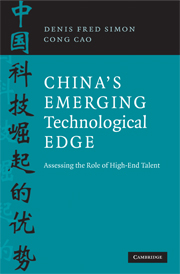Book contents
- Frontmatter
- Contents
- List of Figures and tables
- Acknowledgements
- Abbreviations
- Introduction
- 1 Human resources, technological innovation, and economic growth
- 2 China's talent challenge
- 3 Human resources in science and technology, and their structure and characteristics in China
- 4 Higher education and scientists and engineers in the pipeline
- 5 Utilization of scientists and engineers in China
- 6 “Brain drain,” “brain gain,” and “brain circulation”
- 7 Supply and demand of science and technology talent in China: key drivers
- 8 China's talent in key emerging technologies
- 9 Whither China's talent pool?
- Appendix: Understanding Chinese science and technology human resources statistics
- References
- Index
7 - Supply and demand of science and technology talent in China: key drivers
Published online by Cambridge University Press: 25 January 2011
- Frontmatter
- Contents
- List of Figures and tables
- Acknowledgements
- Abbreviations
- Introduction
- 1 Human resources, technological innovation, and economic growth
- 2 China's talent challenge
- 3 Human resources in science and technology, and their structure and characteristics in China
- 4 Higher education and scientists and engineers in the pipeline
- 5 Utilization of scientists and engineers in China
- 6 “Brain drain,” “brain gain,” and “brain circulation”
- 7 Supply and demand of science and technology talent in China: key drivers
- 8 China's talent in key emerging technologies
- 9 Whither China's talent pool?
- Appendix: Understanding Chinese science and technology human resources statistics
- References
- Index
Summary
The previous chapters have surveyed the prevailing situation regarding China's scientific and technical workforce and the higher education system that is responsible for producing the next generation of scientists and engineers. In particular, we have argued that the expansion of university enrollments since 1999 has created an increasing supply of graduates, perhaps even oversupply, in science and technology (S&T) and other disciplines. And, we also have shown that, at the same time, despite admissions having increased, both foreign-invested and domestic employers in China continue to face a growing challenge of finding appropriate candidates for employment with not only adequate educational credentials but also the right skills, competencies, and experience for the highly skilled jobs that they increasingly need to fill. In other words, China continues to face a “talent shortage” in terms of the gap between supply and demand. This kind of mismatch derives primarily from the imbalance between quality and quantity, between the specific skills required for jobs available and what the job candidates learned in school, and between localities that have open positions and the willingness of S&T personnel to relocate, among other issues.
From the perspective of available statistics and data, however, it is one thing to pinpoint the existence of China's talent problem, but quite another to quantify the actual size of the gap between supply and demand. In this chapter, we highlight and analyze the drivers behind both supply and demand for scientists and engineers in China over the next few years.
- Type
- Chapter
- Information
- China's Emerging Technological EdgeAssessing the Role of High-End Talent, pp. 254 - 283Publisher: Cambridge University PressPrint publication year: 2009



